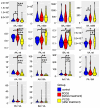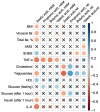Impact of Gut Microbiota and SCFAs in the Pathogenesis of PCOS and the Effect of Metformin Therapy
- PMID: 39408965
- PMCID: PMC11477200
- DOI: 10.3390/ijms251910636
Impact of Gut Microbiota and SCFAs in the Pathogenesis of PCOS and the Effect of Metformin Therapy
Abstract
Polycystic ovary syndrome (PCOS) is a complex disorder that impacts both the endocrine and metabolic systems, often resulting in infertility, obesity, insulin resistance, and cardiovascular complications. The aim of this study is to investigate the role of intestinal flora and its metabolites, particularly short-chain fatty acids (SCFAs), in the development of PCOS, and to assess the effects of metformin therapy on these components. SCFA levels in fecal and blood samples from women with PCOS (n=69) and healthy controls (n=18) were analyzed using Gas Chromatography-Mass Spectrometry (GC/MS) for precise measurement. Fecal microbiota were quantitatively detected by real-time polymerase chain reaction (PCR). To assess the efficacy of six months of metformin treatment, changes in the microbiota and SCFAs in the PCOS group (n=69) were also evaluated. The results revealed that women with PCOS exhibited a significant reduction in beneficial bacteria (namely, the C. leptum group and Prevotella spp.) alongside a notable overgrowth of opportunistic microorganisms (C. perfringens, C. difficile, Staphylococcus spp., and Streptococcus spp.). An overproduction of acetic acid (AA, FC=0.47, p<0.05) and valeric acid (VA, FC=0.54, p<0.05) suggests a link between elevated SCFAs and the development of obesity and PCOS. Interestingly, AA in the bloodstream might offer a protective effect against PCOS by ameliorating key symptoms such as high body mass index (r=-0.33, p=0.02), insulin resistance (r=-0.39, p=0.02), and chronic inflammation. Although serum SCFA levels showed non-significant changes following metformin treatment (p>0.05), the normalization of AA in the gut underscores that metformin exerts a more pronounced effect locally within the gastrointestinal tract. Furthermore, the study identified the most effective model for predicting the success of metformin therapy, based on serum concentrations of butyric acid (BA) and VA, achieving a 91% accuracy rate, 100% sensitivity, and 80% specificity. These promising findings highlight the potential for developing targeted interventions and personalized treatments, ultimately improving clinical outcomes for women with PCOS.
Keywords: gas chromatography-mass spectrometry; intestinal microbiota; metabolomics; pathogenesis; polycystic ovary syndrome; short-chain fatty acids.
Conflict of interest statement
The authors declare no conflicts of interest.
Figures






Similar articles
-
Effects of Sleeve Gastrectomy on Fecal Gut Microbiota and Short-Chain Fatty Acid Content in a Rat Model of Polycystic Ovary Syndrome.Front Endocrinol (Lausanne). 2021 Nov 11;12:747888. doi: 10.3389/fendo.2021.747888. eCollection 2021. Front Endocrinol (Lausanne). 2021. PMID: 34858330 Free PMC article.
-
Gut microbiota and gut-derived metabolites are altered and associated with dietary intake in women with polycystic ovary syndrome.J Ovarian Res. 2024 Nov 22;17(1):232. doi: 10.1186/s13048-024-01550-w. J Ovarian Res. 2024. PMID: 39578890 Free PMC article.
-
Fecal propionate is a signature of insulin resistance in polycystic ovary syndrome.Front Cell Infect Microbiol. 2025 Jan 13;14:1394873. doi: 10.3389/fcimb.2024.1394873. eCollection 2024. Front Cell Infect Microbiol. 2025. PMID: 39872943 Free PMC article.
-
Gut Microbiota and Polycystic Ovary Syndrome (PCOS): Understanding the Pathogenesis and the Role of Probiotics as a Therapeutic Strategy.Probiotics Antimicrob Proteins. 2024 Oct;16(5):1553-1565. doi: 10.1007/s12602-024-10223-5. Epub 2024 Feb 29. Probiotics Antimicrob Proteins. 2024. PMID: 38421576 Review.
-
Balancing Act: Exploring the Gut Microbiota-Brown Adipose Tissue Axis in PCOS Pathogenesis and Therapeutic Frontiers.Front Biosci (Landmark Ed). 2024 May 30;29(6):208. doi: 10.31083/j.fbl2906208. Front Biosci (Landmark Ed). 2024. PMID: 38940030 Review.
Cited by
-
Association between dietary index for gut microbiota and female infertility: a cross-sectional NHANES 2013-2020.Front Nutr. 2025 Apr 23;12:1587240. doi: 10.3389/fnut.2025.1587240. eCollection 2025. Front Nutr. 2025. PMID: 40336961 Free PMC article.
-
Characteristics of Gut Microbiota in Patients with Polycystic Ovary Syndrome and Its Association with Metabolic Abnormalities: A Review.Int J Womens Health. 2025 Jul 18;17:2165-2174. doi: 10.2147/IJWH.S522708. eCollection 2025. Int J Womens Health. 2025. PMID: 40698041 Free PMC article. Review.
References
-
- Mizgier M., Watrowski R., Opydo-Szymaczek J., Jodłowska-Siewert E., Lombardi G., Kędzia W., Jarząbek-Bielecka G. Association of Macronutrients Composition, Physical Activity and Serum Androgen Concentration in Young Women with Polycystic Ovary Syndrome. Nutrients. 2022;14:73. doi: 10.3390/nu14010073. - DOI - PMC - PubMed
MeSH terms
Substances
Grants and funding
LinkOut - more resources
Full Text Sources
Medical
Miscellaneous

